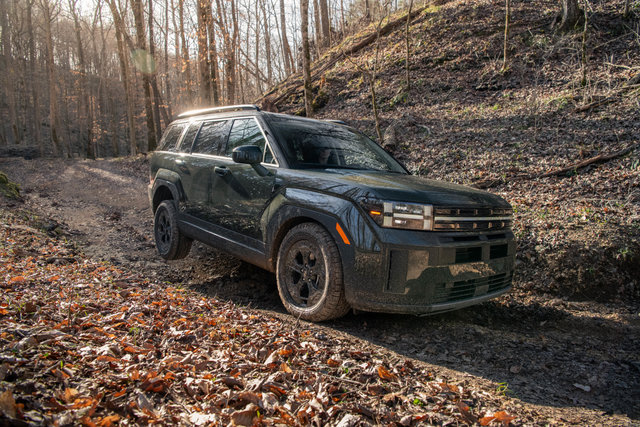The 2025 Hyundai Santa Fe offers two powertrain options that cater to different types of drivers: a traditional gasoline engine and a fuel-efficient hybrid system. Both engines bring unique strengths to the table, but they differ significantly in terms of fuel consumption and overall running costs. This article will provide a comprehensive comparison of the fuel economy of both models, breaking down the potential costs for drivers with different annual mileage. This information will help prospective buyers understand the key differences in fuel costs, allowing them to make an informed decision based on their driving needs.
Powertrain Options in the 2025 Hyundai Santa Fe
The gas-powered 2025 Hyundai Santa Fe is equipped with a 2.5L Turbo-GDI + MPI 4-cylinder engine, delivering 277 horsepower at 5,800 RPM and 311 lb-ft of torque between 1,700 and 4,000 RPM. This engine provides robust performance with strong acceleration, making it an appealing choice for drivers who prioritize power and responsiveness.
The hybrid variant of the Santa Fe features a 1.6L Turbo-GDI 4-cylinder engine paired with a hybrid system. This combination produces 231 horsepower at 5,600 RPM and 271 lb-ft of torque from 1,000 to 5,100 RPM. The hybrid model focuses on fuel efficiency and reduced emissions, making it a great option for eco-conscious drivers or those who want to save on fuel costs, particularly in city driving conditions where hybrids are most effective.
Fuel Economy of the Gas and Hybrid Models
The fuel economy of the gas and hybrid versions of the 2025 Santa Fe reveals notable differences in efficiency:
- Gas Engine (2.5L Turbo-GDI): The gas model has an average fuel consumption of 12.2 L/100 km in the city, 9.1 L/100 km on the highway, and 10.8 L/100 km combined.
- Hybrid Engine (1.6L Turbo-GDI Hybrid): The hybrid variant excels in efficiency, with a fuel consumption of 6.8 L/100 km in the city, 6.9 L/100 km on the highway, and a combined rating of 6.9 L/100 km.
These figures highlight the hybrid’s superior fuel economy, especially in urban settings where the hybrid system's electric motor reduces fuel use during low-speed, stop-and-go traffic.
Fuel Cost Scenarios Based on Annual Driving Distances
To better understand the financial implications of choosing between the gas and hybrid models, let’s explore three different driving scenarios based on annual mileage: 10,000 km, 20,000 km, and 30,000 km. For the cost calculation, we assume a fuel price of $1.50 per litre.
Scenario 1: 10,000 km per Year
For a driver who travels 10,000 km per year, the gas model consumes about 1,080 litres annually, resulting in a fuel cost of approximately $1,620. In contrast, the hybrid model would use about 690 litres over the same distance, costing around $1,035. This results in a cost difference of $585, highlighting the potential savings of the hybrid over shorter annual distances.
Scenario 2: 20,000 km per Year
For a driver covering 20,000 km per year, the gas-powered Santa Fe would use around 2,160 litres of fuel, costing about $3,240 annually. The hybrid, on the other hand, would consume roughly 1,380 litres, costing approximately $2,070. This scenario shows a larger annual savings of $1,170 when choosing the hybrid model, making it a cost-effective option for moderate to high mileage drivers.
Scenario 3: 30,000 km per Year
High-mileage drivers, who travel 30,000 km annually, would see even more pronounced differences. The gas model would consume about 3,240 litres of fuel, translating to an annual cost of $4,860. Meanwhile, the hybrid would use approximately 2,070 litres, costing around $3,105 per year. This results in a significant cost difference of $1,755, demonstrating the hybrid’s advantage in reducing fuel expenses for those with high driving demands.
Summary of Fuel Cost Differences
The table below summarizes the annual fuel consumption and costs for both the gas and hybrid models across the three driving scenarios:
|
Driving Distance (km/year)
|
Gas Model (10.8 L/100 km)
|
Hybrid Model (6.9 L/100 km)
|
Annual Savings with Hybrid
|
|
10,000 km
|
1,080 litres / $1,620
|
690 litres / $1,035
|
$585
|
|
20,000 km
|
2,160 litres / $3,240
|
1,380 litres / $2,070
|
$1,170
|
|
30,000 km
|
3,240 litres / $4,860
|
2,070 litres / $3,105
|
$1,755
|
Conclusion
The 2025 Hyundai Santa Fe offers both gas and hybrid powertrains, each with distinct benefits. The hybrid model provides clear fuel savings across all driving scenarios, particularly for those who drive frequently or cover long distances annually. However, the gas model offers a powerful driving experience and may be more appealing to those who prioritize performance. Ultimately, the decision between the two comes down to balancing fuel economy needs with driving preferences and understanding how the fuel cost differences align with your lifestyle.






